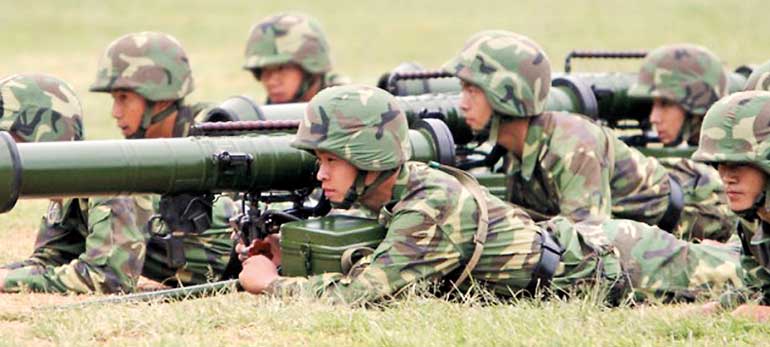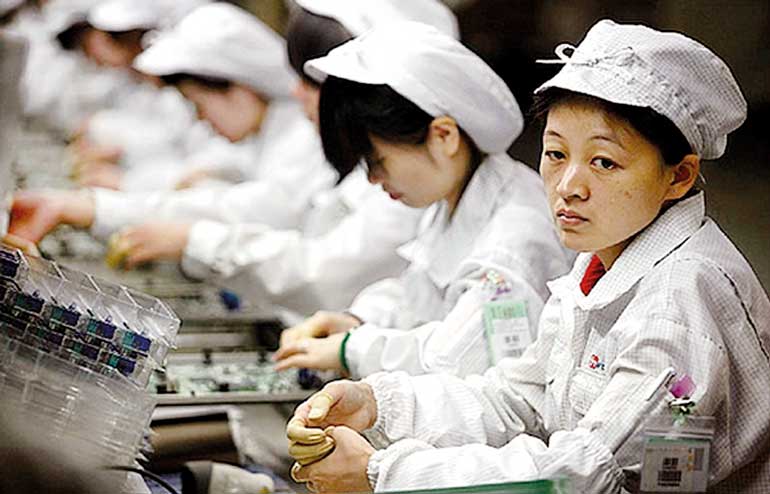Wednesday Mar 12, 2025
Wednesday Mar 12, 2025
Saturday, 22 July 2017 00:02 - - {{hitsCtrl.values.hits}}
Even as war clouds gather over the Sino-Bhutan border where China’s real adversary is nuclear-armed India, China has announced its intention to thoroughly overhaul its military and economic structure and philosophy to meet challenges of the emerging world order.
The idea is to make China’s economy and military meet needs arising from its expanding global interests as reflected in its One Belt One Road (OBOR) global communication and infrastructure project.

President Xi Jinping has made reform and expansion of the economy and the military his platform in his bid to continue as the Communist Party chief when the 19th Congress of the Communist Party of China (CPC) is held in autumn this year.
Xi, who is General Secretary of the CPC Central Committee, and Chairman of the Central Military Commission (CMC), unveiled on Wednesday, his master plan at the 37th meeting of the Central Leading Group for Deepening Overall Reform (CLGDOR), which he heads.
The CLGDOR resolved that all branches of government should be devoted to reforms and make “concrete and pioneering efforts” towards that end. It called for a green and sustainable development in agriculture; ensuring grain safety and raising farmers’ incomes. It urged the establishment of a national technology transfer system with a focus on strategic industries of far-reaching significance.

Given the importance of inculcating the right culture among the people, it called upon public cultural institutions to improve their management and services, and to inject vitality into these institutions. Efforts should be made to raise the professional level of civil servants by recruiting people with special expertise, it said.
In view of the OBOR, the CLGDOR emphasised the need for improving people-to-people communication with other countries, “with confidence in the path, theories, system and culture of socialism with Chinese characteristics”.
Military reform
On Wednesday again, President Xi called on the country’s major military research and educational institutions to nurture talent and aim to be world-class.
After presenting the heads of the three institutions with the military flag at a ceremony that marked the reshuffling of these institutions, Xi called the reshuffling a vital decision made by the CPC Central Committee and the CMC to realise the “Chinese Dream” of having a “stronger army.”
The President emphasised the need for first class research in military science to devise methods to combine theories with technological innovations.
Stressing the need for coordinated action under a unified command, Xi that military institutions should inculcate the habit of coordinating thinking and action among the various branches of the People’s Liberation Army (PLA). The PLA is a unified armed force with ground (Army), air (Air Force) and sea (Naval) wings. Within the PLA there are Strategic and Rocket forces which are separately organised. The overall control is exercised by the Central Military Commission (CMC) which is a politico-military body headed by the President himself.
“It takes first-class military talent, theory, and science and technology to build the PLA into a world-leading military,” Xi told the heads of PLA units.
But overall control must be in the hands of the political leaders of the country, and military officers and men must be imbued with the right political ideology to be able to work according to the nation’s basic principles, he said.
He therefore “ordered” the chief officers to stick to the correct political direction by safeguarding the authority and the centralised and unified leadership of the CPC Central Committee; conforming to the CPC Central Committee; and upholding CPC’s absolute leadership over the military.
As on date, there are now 43 military education institutions, including two – the National Defence University of PLA and the National University of Defence Technology – directly under the CMC, 35 specialised in specific armed services, and six of armed police forces.
Making PLA lean and mean
Xi is determined to make the wobbly Soviet model 2.2 billion strong PLA into a “leaner and meaner” modern American-style fighting machine. It recently announced a cut of one million men, which will affect the army mainly.
The emphasis from now on will be upon the naval, strategic, rocket and air forces in preparation to face threats from long distances, and to fight in far-flung areas given its global OBOR project. China is aware that its regional rivals, Japan and India are preparing to fight long distance wars.
Saving money is hardly the criterion for the numerical cuts, but putting money to better use is.
China is still one of the highest spenders on the military in the world. From 2005 to 2014, its military expenditure is estimated to have increased in real terms from $ 71 billion to $ 191 billion, making the country the second-largest spender after the US, according to the Stockholm International Peace Research Institute (SIPRI).
The rate of increase in China’s military spending is the highest in Asia. Between 2013 and 2014, China’s military expenditure increased by 63.4% while that of Japan went up by only 5.7% and India’s by 14.2%.
However, according to Xinhua, the PLA’s budget for 2017 has been pruned to $ 153 billion. The US defence budget is much higher at $ 583.7 billion. China’s per capita military spending represents only about 5.6% of that of the US; 11% of Britain’s; and 25% of Japan’s, Xinhua points out.
According to Dr.Satoru Nagao of the Integrated Area Studies on South Asia Gakushuin University in Japan, China does not have enough weapons for all its men in uniform, and therefore it has decided to cut down the number of men and equip the remaining well.
According to another expert, Beijing is preparing to counter US deployment of Terminal High Altitude Area Defense (THAAD) interceptor missiles in South Korea, whose powerful radars could see through most part of China including its missile development program. China is also aware the India is also improving its missile capability besides being nuclear armed.
Since Xi’s announcement of reducing the number of troops by 300,000 in 2015, the PLA has founded a Strategic Support Force dedicated to electronic, information and space operations, and established a Rocket Force to replace the former Second Artillery Corps.
Centralisation of command
The complexity and destructiveness of modern warfare also demand centralisation and therefore, the Rocket Force, the Special Strategic Forces and Cyber warfare forces will be under a central command at the Central Military Commission (CMC). According to Jean-Pierre Cabestan, Director for Government and International Studies at Hong Kong Baptist University, despite the CMC, the PLA is still very much compartmentalised and lacking in coordination.
Another goal of the reform is to put China’s navy and air force on a more equal footing with the traditionally dominant ground force. The navy and air force and not the army, will be the cutting edge of the PLA.
Discover Kapruka, the leading online shopping platform in Sri Lanka, where you can conveniently send Gifts and Flowers to your loved ones for any event including Valentine ’s Day. Explore a wide range of popular Shopping Categories on Kapruka, including Toys, Groceries, Electronics, Birthday Cakes, Fruits, Chocolates, Flower Bouquets, Clothing, Watches, Lingerie, Gift Sets and Jewellery. Also if you’re interested in selling with Kapruka, Partner Central by Kapruka is the best solution to start with. Moreover, through Kapruka Global Shop, you can also enjoy the convenience of purchasing products from renowned platforms like Amazon and eBay and have them delivered to Sri Lanka.
Discover Kapruka, the leading online shopping platform in Sri Lanka, where you can conveniently send Gifts and Flowers to your loved ones for any event including Valentine ’s Day. Explore a wide range of popular Shopping Categories on Kapruka, including Toys, Groceries, Electronics, Birthday Cakes, Fruits, Chocolates, Flower Bouquets, Clothing, Watches, Lingerie, Gift Sets and Jewellery. Also if you’re interested in selling with Kapruka, Partner Central by Kapruka is the best solution to start with. Moreover, through Kapruka Global Shop, you can also enjoy the convenience of purchasing products from renowned platforms like Amazon and eBay and have them delivered to Sri Lanka.